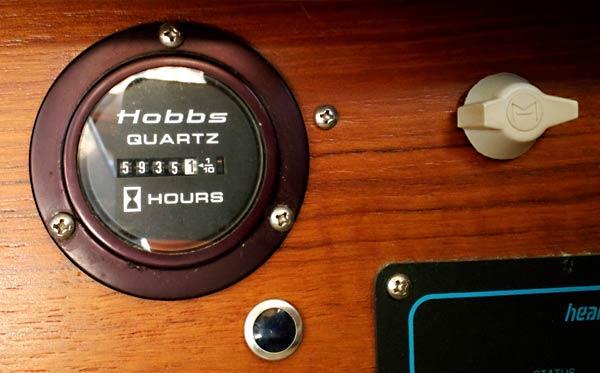March 28, 2015

We’re replacing our refrigeration. It’s still working, but it’s struggling. The reason I know it’s having problems is that we have an hour meter installed and I use a little spreadsheet to keep track of its running time. Recently, it’s gone from about 3 1/2 hours per day to 4 1/2 hours per day.
Without knowing about the increased run hours, it probably would have quit during this season’s cruising. Like so many cruisers, I’d be stuck in tropical paradise, trying to find a refrigeration mechanic. (Knock, knock, knock… I know it could still happen, even with new refrigeration, so I’ll ward off the evil spirits with that wood-knocking thing.)
For the curious, the increased run time is due to low coolant levels. We have a very slow leak somewhere. It’s a holding-plate system with a large, one third horsepower DC motor on a big compressor. It’s been on the boat for 20+ years and has been great. The leak is so slow, we’d probably never find it so we’d be stuck topping up the coolant every year, then every six months, then… The whole system is getting very old and it’s time to make a change.
We’re going to a more modern, Danfoss compressor and an evaporator instead of the holding plate. With this change, we’re going to get a little freezer inside our evaporator box. Yay! The new system should use less power. Yay!
I’m going to install the hour meter on the new system and track it’s run time. It also tells us exactly how much energy we’re using for refrigeration. When we turn the box temperature down to freezer levels (like we do for extended Fulaga stays), we can tell exactly what that costs us in terms of energy. We can also see what being in the tropics costs us in battery power (not that there’s anything we can do about it, but it’s interesting to me).
By the way, that knob next to the hour meter is a mechanical timer. We can twist it and, regardless of the fridge temperature, cause the compressor to run for up to an hour. This is handy. When motoring, we turn it on an hour before getting into an anchorage and essentially store an extra 26 amp-hours in our fridge. The little light below goes on anytime the fridge is running. We can usually hear our big holding plate unit running but not when the engine is on. Hopefully, we won’t be able to hear our new Danfoss compressor adding even more value to having the indicator light. It’s just a handy, cheap indicator.
Another side note: I’m a big fan of the mechanical hour meters. At least, when they fail, you know the last reading. The digital ones store that reading in smoke, and when the smoke gets out…
Here’s a copy of the spreadsheet I use. Help yourself. Just delete my first two lines of sample data and start filling in your own. fridge hours
-Rich






